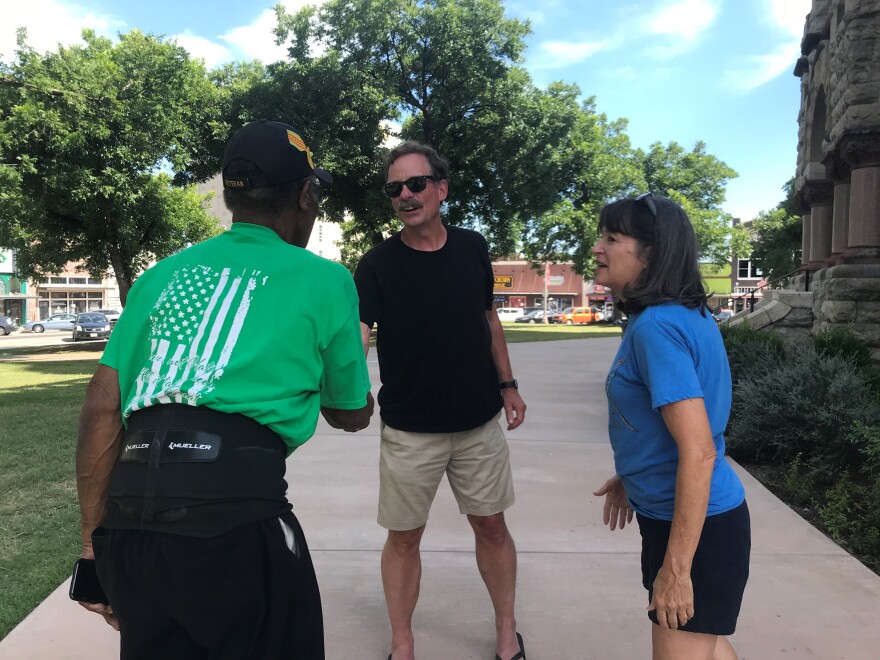The statue of a young man stands with a rifle, facing south, on top of a white stone arch with the words "Our Confederate Soldiers."
It has stood in Denton's town square since 1918, but earlier this month the Denton County Commissioners Court voted unanimously to remove and relocate it.
County Judge Andy Eads called the decision a matter of public safety, and said it was to protect the monument from vandalism, as demonstrations over the killing of George Floyd continue across the nation. But it’s hard to imagine the commissioners coming to that decision without the decades of protest by Denton’s Willie Hudspeth.

Sitting on a bench in the square, Hudspeth questioned why the statue was put up to begin with.
“The word O-U-R is on it. ‘Our Confederate soldiers.’ So, who is ‘our?’” he said. “It most certainly isn’t black people. They were trying to get rid of us, or keep us in slavery.”
Hudspeth moved to Denton in 1970 after fighting in the Vietnam War and has been deeply involved in civic life. But he's best known for his campaign against the statue, which he started in the late '90s.
He's spent countless Sunday evenings protesting in the town square. Often, he didn’t have many supporters there with him. A 1999 Denton Record-Chronicle article about Hudspeth’s protest opened like this:
“A rally calling for racial unity at the site of a Confederate monument in Denton attracted more reporters than participants Friday, but its organizer was undaunted.”
Hudspeth's opinion on what should be done with the statue has changed over the years. He said at first, he wanted the water fountains attached to the arch turned on and a contextual plaque placed nearby. At another point, he wanted the whole thing torn down and tossed out.
Now, he wants to see it preserved, but moved — which is what the county has agreed to do.
"We're starting a new journey, which is, I'm gonna tell them where that thing should go,” he said.

In recent weeks, anti-racism demonstrations have brought down similar monuments across the South.
In some cases, protesters are tearing them down — like the statue of Confederate President Jefferson Davis in Richmond, Va.
In other places, local governments are deciding to get rid of them. Tarrant County commissioners voted to remove a Confederate monument in front of the county courthouse the same day Denton did.
Daina Ramey Berry is a history professor at the University of Texas at Austin, where she served on a committee to help the university contextualize the Confederate symbols on campus.
She said some Confederate monuments were put up decades after the Civil War. In fact, the one in Fort Worth was erected in 1953.
Berry said they commemorate a glorified version of Southern history — and stressed that racism and violence against black Americans didn't end with the Civil War.
"African Americans are not able to go into particular buildings, they're limited in public spaces, they have to use a different ticket window to go to the theater or the amusement parks, and all kinds of restrictions take place upon their lives,” she said. “At the same time, these statues were being put up to celebrate the Confederacy."
Berry said some of the modern push to take down Confederate symbols started with the massacre of nine black churchgoers in Charleston, South Carolina, in 2015.
Activist Bree Newsome Bass famously climbed the flagpole outside the South Carolina State House and took down the Confederate flag that flew there.
Many Confederate monuments were also removed after a white supremacist rally in Charlottesville, Virginia, two years later.
"A lot of these statues have been taken down in protest, been taken down in moments where we see the ramifications of race relations, the ramifications of Jim Crow-era segregation, the ramifications of police brutality today,” Berry said.
Hudspeth said he's cautiously optimistic the monument in Denton will come down, and he's glad that throughout this journey, he kept an open mind while staying focused on his goal.
He said he'll return to the town square with new missions, like fighting sex trafficking.
And he's also getting some recognition for his work over the last 20 years.
The mayor of Denton has designated the day the commission voted to remove the monument as Willie Hudspeth Day.
Got a tip? Email Reporter Miranda Suarez at msuarez@kera.org. You can follow her on Twitter @MirandaRSuarez.
KERA News is made possible through the generosity of our members. If you find this reporting valuable, consider making a tax-deductible gift today. Thank you.






